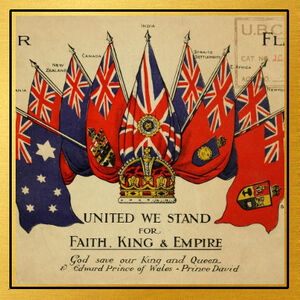| Era of Revolutions and the British Empire | |
| Period | Late Modern Ages |
| Dates | 1815-1847 AD |
| Chronology | |
| Preceded by Age of Napoleon Bonaparte |
Followed by Year of Revolutions and Unifications |
| “ | Trade cannot be maintained without war, nor war without trade. The times now require you to manage your general commerce with your sword in your hands. | ” |
–Jan Coen | ||
The Era of Revolutions and the British Empire lasted from about 1815 AD until 1847 AD. It began with Napoleon’s downfall and exiled to the island of St Helena. It then merged into the most widespread revolutionary wave in European history, Year of Revolutions in 1848.
During the post-Napoleonic era, radical notions prove hard to quarantine, and the contagion of revolution spread. France, Italy, Spain, Russia, Ireland, and even Britain experienced their troubles but none as dramatically as Latin America and Greece which achieved their independence. Meanwhile, Britain boasted an unchallenged dominance of the world, as dramatically demonstrated in the conquest of India and and humbling China in the Opium Wars. By the end of the century, the British Empire controlled a fifth of the world's land and one quarter of the world's population.
History[]
Post-Revolutionary France[]

Portrait of Charles X by Henry Bone
With the second restoration of the monarchy, King Louis XVIII (1815-24) accepted for the most part that much had changed in France. While he refused to sign the constitution prepared by parliament, he instead granted from the king to his subjects a relatively progressive charter of government and civil rights, an ambiguous marriage of absolutist and constitutional monarchy. He contrived throughout his reign to steer a moderate course between the liberals and the new ultra-royalist faction with vengeance for their sufferings high on the agenda. However, his task was made more difficult by the assassination of his nephew the Duc de Berry in 1820, the son of the leader of the ultra-royalists; his younger brother and the future Charles X. The drift towards reactionary policies accelerated when Charles X (1824-30) succeeded his brother, determined to re-establish as much as possible the social, political, and economic divisions of the Ancien Régime. As a dramatic statement of intent, Charles had himself crowned with full medieval pomp in Rheims cathedral. He selected increasingly right-wing ministers, reasserted the power of the Catholic Church, and allotted large sums of money to recompense the aristocracy for lost lands. Yet he found himself repeated thwarted by parliament. Wary of repealing the charter of government introduced by Louis XVIII, in the elections of June 1830 the king tried to use every dirty trick he could think of to defeat the liberal opposition, including a successful war in Ottoman Algeria, only for parliament to be returned with an even bigger liberal majority. In angry resentment, Charles issued the four ordinances: dissolving the newly elected chamber, calling for fresh elections, unscrupulously amending the franchise to favour large conservative landowners, and severely curtailing freedom of the press. A royal-coup had long been expected, though given how hopelessly ill-prepared the government was for the dramatic response this was no one.
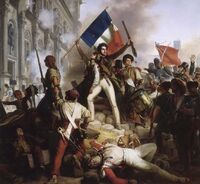
Battle outside the Hôtel de Ville, by Jean Victor Schnetz
As soon as the news of the ordinances hit Paris, barricades once again appeared on the streets with angry crowds brandishing the tricolour; the July Revolution (1830). After three days of street violence, Charles fled the country and his more liberal cousin, Louis Philippe (1830-48) was offered the crown. Readily embraced his role as Citizen King, he was formally proclaimed “King of the French... by the will of the people”. Nevertheless, he found it hard to govern a nation in which the number of disaffected factions increased with each regime change: many liberals felt the July Monarchy was a betrayal of the revolution of 1830 for not expanding the franchise beyond the wealthiest bourgeoisie; the extreme left-wing were finding new support in the increasingly industrialised French cities; a Bonapartist faction dreamed of a new empire linked with Napoleon’s family; and the ultra-royalists were now split between supporters of Louis Philippe and those believing Charles X’s grandson was the rightful king. The result was a reign both unsettled and violent. There were several attempts on the king’s life and frequent uprisings. The predictable response was a clampdown on political liberties. France would be the first major domino to drop in the most widespread revolutionary wave in European history; the Revolutions of 1848.
Road to Unification in Germany[]
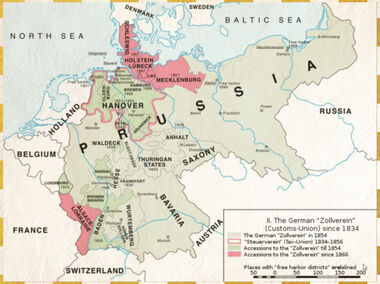
After an otherwise dismal Napoleonic War, Prussia was one of the big winners from Treaty of Paris (1815). She was firmly re-established as a great power, after receiving large chunks of Poland and Saxony, as well as the Rhineland and Westphalia. These latter industrial regions transformed agrarian Prussia into an industrial leader in the region, ready to contest with Austria the leadership of all the German states. The German states, much reduced in number as a result of Napoleon's reorganisation, now consist of thirty-five monarchies of various kinds and four free cities. They were organised from 1815 into a revised version of Napoleon’s Confederation of the Rhine called the German Confederation. Good relations within the Confederation depended on an understanding between the two most powerful members, Austria and Prussia. In 1818, King Frederick William of Prussia introduced economic reforms that would be of profound significance. His newly acquired regions of Rhineland and Westphalia were isolated from the rest of Prussia, so in an effort to bind together his extended kingdom, he turned all his territories into a single customs-free zone; the Zollverein. The benefit to trade quickly encouraged neighbouring states to join this customs union, and by 1834 it covered almost the whole of Germany, with Austria deliberately excluded. Thus as if by the back door, Prussia had acquired the leadership role in Germany. All that was needed was a statesman with the skill to set Germany on the road to unification; in 1862 Otto von Bismarck became prime minister of Prussia.
Road to Unification in Italy[]
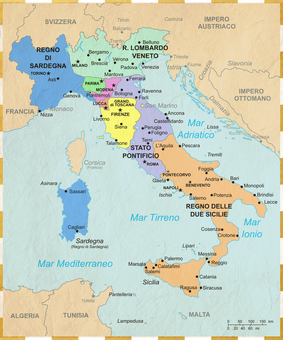
Meanwhile a similar process towards unification was taking place in Italy. With the end of the Napoleonic Wars, the patchwork of royal dynasties was almost entirely restored in the peninsula and its islands. However, there remained many in Italy who had first-hand experience of the modern French style of administration, and craved independence from these reactionary autocratic rulers. Napoleon's hold of the entire peninsula had also influenced some to envision of a united Italy under a single government. The first real success of these radicals was the revolution in Naples in 1820 that briefly brought in a liberal constitution. Nine months later, the Austrians were invited in to restore it to absolutist rule. The pattern of Austrian involvement was soon repeated elsewhere; Piedmont in 1821 and the Papal State in 1831. These events prompted new policies among Italy's radicals; the removal of the Austrians from the peninsula would be a key aim of the Year of Revolutions of 1848.
Independent Belgium[]
National Awakening of the Balkans[]
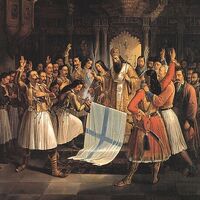
Oil painting by Theodoros Vryzakis (1852) illustrating Bishop Germanos blessing the Greek banner at Agia Lavra at the outset of the revolt against the Ottomans in 1821.
Greece had been part of the Ottoman Turkish Empire since 1460. Ottoman Greece was a relatively tolerant and multiethnic society. As well as Greeks and Turks, there were many Jews, Italians especially Venetians, Armenians, Serbs, Albanians, Roma Gypsies, and Bulgarians. The Greeks enjoyed some privileges and freedom, and thrived especially in business and commerce. Yet they also suffered under the often corrupt Ottoman bureaucracy. Early in the 19th century, there were several schemes by Greek aristocrats for a revolution to liberate the country. Prominent among these groups was the Philiki Etaireia or Friendly Band founded in 1814 by Greeks living in the Russian port of Odessa on the Black Sea. In March 1821, Alexandros Ypsilantis the leader of the group led a small force south through the Balkans with some Russian support; the Greek War of Independence (1821-29). His expedition ended in failure and defeated against the Turks near Bucharest, but the attempt provoked impromptu uprisings in several parts of Greece, beginning on 25 March; now celebrated as the Greek Independence Day. The massacre of Muslims by Greek insurgents was followed by Turkish reprisals. The uprising quickly descended into a guerrilla war in the mountainous regions of Greece, which baffled the Turkish armies. Though they were able to subdue much of the Peloponnese in the south, they were unable to suppress entirely the Greek resistance. Meanwhile the struggle was attracting international attention, as a romantic fight for liberty by Europe’s first democrats. The result was the arrival in Greek waters of fleets in 1827 from an alliance between Britain, Russia and France. Their intention was merely to threaten an economic blockade, but in October, more by accident than design, they encountered the Turkish and Egyptian fleets at Navarino. In the battle, the Muslims lost sixty ships and men, with very light allied casualties. It proved the turning point on the road to Greek independence. Though it dragged on for another five years, in the Treaty of Constantinople (1832), Turkey relinquishes all sovereignty over the Peloponnese and Central Greece. The first king of independent Greece was prince Othon of Bavaria.
Troubled Spain[]
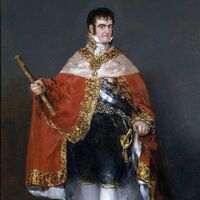
Portrait of Ferdinand VII in his robes of state by Goya, 1815
The Peninsular War (1808-14) provided the first clashes between Spain’s the two great political factions of the 19th century; the liberals and conservatives. The liberals prevailed during the war, introducing a constitution in 1812 combining elements from Britain's constitutional monarchy with a strong dash of the idealism from the American and French revolutions. However once Ferdinand VII (1808-33) was safely back on his throne in 1814, he reneged on his promises, restored absolute rule, and savage persecuted his liberal opponents. His behaviour alienated many in Latin America and hastens the independence movements that were already under way. When Ferdinand proposed sending an army across the Atlantic to suppress the rebellious colonists, the indignation in Spain was enough to prompt another successful liberal revolution; the Trienio Liberal (1820-23). Ferdinand found himself a prisoner, forced to accept the constitution of 1812. However, in 1823 help duly arrived in the form of an army from France. Within weeks Ferdinand was freed, and his persecution of the liberals became even more vindictive until his death in 1833. The extreme swings during Ferdinand's reign set a violent precedent for Spain in the 19th century. Ferdinand’s death split the royalists between supporters of his only daughter the infant Isabella and his brother Carlos. Carlos was even more autocratic in his views than Ferdinand, so the conflict within the royal family became associated with the conservative and liberal political division. The First Carlist War (1833-39) ended with Isabella II on the throne but chaotic clashes continued throughout the 19th century. In fact Spain remained something of Europe’s basket-case well into the 20th century. Meanwhile, political chaos in Spain prompted a passionate sense of regional independence in the Basques and Catalans. Throughout Spanish history these two regions had been much involved with neighbouring France, linked with both Spain and France but identifying with neither. The separatist tendency in north-eastern Spain has remained a central feature of Spanish political life right down to the present day.
Latin American Independence[]
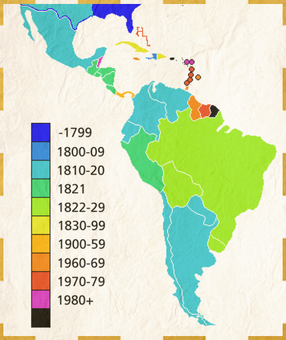
The upheavals of the American and French Revolutions had little immediate effect on most of Latin America, other than on French islands of the Caribbean. By 1801, the whole of Haiti was under the control of the first revolutionary hero of Latin America, Toussaint L'Ouverture. Though there had been little sign of active rebellion, the heady ideals of the revolutions led some in Spanish-America to dream of change. The social hierarchy there was exceptionally rigid: at the top were those Spanish born, followed by Creoles or pure Europeans born in the colonies, then by people of mixed European and Indian-African ancestry, and at the bottom the American Indians and Africans. Things changed abruptly in 1807-08 when Napoleon sent French armies into the Iberian Peninsula and usurped the Spanish crown. With no legitimate government in Spain, Latin America increasingly argued that the colonies must look after themselves. The first two outbreaks of rebellion occurred in Bolivia and Ecuador during 1809. Both were soon put down and their leaders executed, but the theme was infectious across the continent with varying degrees of success: Venezuela rebelled in April 1810, Argentina in May, Columbia in July, Mexico and Chile in September, Paraguay in May 1811, and Uruguay later that year.
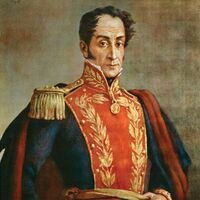
Portrait of Simón Bolívar
The central figure in the story of the Latin American independence movements was Simón Bolívar, a young officer from Venezuela. He was part of the junta that expelled the Spanish governor from Venezuela in April 1810, only for Spain to regain control by July 1812. Bolívar escaped to neighbouring Colombia where a rebellion was ongoing, from where he penned his famous political pamphlet calling for a united effort to expel the Spanish. For the next several years, Bolivar fought at the head of an army of liberation across Columbia and Venezuela, defeating the Spanish forces on several occasions but with numerous reverses too. Then in 1819, he did the unthinkable, audaciously marching his small army across the waterlogged plain of the Orinoco and over the treacherous peaks of the Andes to Bogotá. The Spanish were in disbelief when Bolivar’s army emerged from the mountains and at the Battle of Boyacá (August 1819), the Spanish army surrendered. With Columbia liberated, he returned to his native Venezuela and defeated the Spanish there too, at the Battle of Carabobo (June 1821). Meanwhile, Ecuador was bought into the free republic of Gran Colombia, when his talented chief of staff Antonio José de Sucre won a victory at the Battle of Pichincha (May 1822).
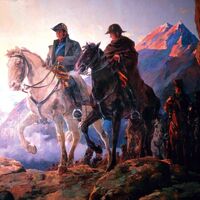
José de San Martín (left) and Bernardo O'Higgins during the crossing of the Andes.
Two months after the fall of Quito, Bolivar had a famous meeting at Guayaquil, with the other great hero of the independence movement; José de San Martín. San Martín was an Argentinian-born officer serving in the Spanish army. He returned to Argentina in 1812, where an independent local government had been established since May 1810. By 1814, San Martín was in command of the patriot forces fighting opposing royalists in the extreme northwest of Argentina. He concluded that Latin America's independence would never be secure until Peru was conquered. Peru was the most conservative and stable of the Spanish viceroyalties with little home-grown revolutionary sentiments. In January 1817, San Martín led a force of five-thousand men into Chile enroute to Peru accompanied by Chilean ally Bernardo O'Higgins, a soldier closely involved in the independence movement there. At the Battle of Chacabuco (February 1817), the revolutionaries won, and San Martín and O'Higgins entered Santiago three days later. With royalist forces still a threat, Chilean independence was not formally proclaimed for another year. Meanwhile, San Martín was preparing the next stage of his campaign of liberation, inviting an eccentric Scottish buccaneer, Thomas Cochrane, to create a Chilean navy. Cochrane had gained a brilliant reputation for his exploits during the Napoleonic Wars but had since been dismissed from the British Navy for financial fraud. Over the next two years, Cochrane harried the Spanish fleet and coastal forts in Peru; his most famous exploit was stealing the largest and fastest frigate in the Spanish-Peruvian fleet from Callao harbour. In November 1820, San Martín was landed by sea near Lima with an invasion army of 4,200 men. News of his arrival caused an entire battalion of 650 local Creoles to change sides to the rebels. With the royalist garrison retreated inland, San Martín entered Lima in July 1821 and proclaimed Peruvian independence.
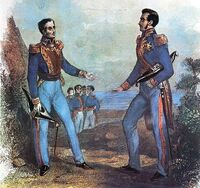
The Guayaquil conference between Simón Bolívar and José de San Martín.
The next stage in the story of Peru was also a turning point in the careers of the two leaders of the American independence movement. Simón Bolívar and José de San Martín met for two days in July 1821 at the port of Guayaquil in northern Peru. The subtext of the meeting was a clash between two men whose personal ambition was incompatible; both want Peru. In the end, San Martín, well-aware that Bolívar was the greater general, opted to withdraw. Afterwards, the man, today acclaimed a national hero of Argentina and Peru, retired to a private life in Europe. In September 1823, Bolívar turned his attention to the Spanish forces based in the near impregnable mountains east of Lima. Yet, he defeated them at the Battle of Junin (August 1824). Bolívar now left the rest of the campaign to Sucre, who went on to win the decisive engagement at Ayacucho (December) where the Spanish army surrendered. This victory completed the liberation of the entire Spanish empire in South America, except for Bolivia. Again Bolívar entrusted this final task to Sucre. Sucre moved into this region early in 1825 and defeated the Spanish at the Battle of Tumusla (April). The new republic was named after Bolívar, and Sucre was elected its first president.
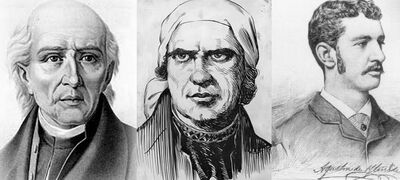
Miguel Hidalgo, José María Morelos, and Agustín de Iturbide
While the various Spanish provinces in South America had found their way to independence led by educated men of pure Europeans blood, in Mexico the first rebels were poor Catholic priests leading armies of poor mixed-bloods and Indians. Napoleon's seizure of the Spanish throne in 1808 provoked many secret societies in Mexico. One such society in San Miguel near Dolores was betrayed to the police, and most of its members were arrested or fled. However one, Father Miguel Hidalgo y Costilla had a different response. On 16 September 1810, celebrated now as Mexico's Independence Day, he rang the bell of his church to summon his parishioners. He then made a passionate speech, proclaiming an end to Spanish rule and racial equality for Mexico. This manifesto had immense appeal with the poor and underprivileged, and they rallied to his banner. He then marched his growing army to Mexico City. However in the suburbs of the capital, Hidalgo mysteriously paused, possibly unwilling to march his undisciplined rabble against trained troops. With the impetus is lost, some of his followers began drifting away, and Hidalgo was defeated at the bridge of Calderón (January 1811). Hidalgo himself was captured, defrocked, and executed by firing squad. However, his cause survived for several more years under his colleague Father José María Morelos y Pavón. Morelos was a more practical leader than Hidalgo. Victories at Oaxaca in 1812 and Acapulco in 1813 gave him control of most of southern Mexico. However, with the restoration of Ferdinand VII to the Spanish throne in 1814 and the arrival of reinforcements from Europe, Morelos was captured in October 1815. Like Hidalgo, he was defrocked and shot as a rebel. When a coup in Spain brought in a liberal government in 1820, the Mexican independence movement revived. The liberal government was profoundly unwelcome to Catholic and conservative circles in Mexico, and the result was the sudden break with Spain led by Agustín de Iturbide, an officer of pure European blood in the Spanish army. He had won his reputation against the independence movements of Hidalgo and Morelos, and his abrupt change of sides united nearly all Mexico behind him. He rapidly won control over the whole of Mexico, and Spain formally recognized its independence on 24 August 1821. The independent Mexican Empire stretched over an area far larger than Mexico itself, from California to Guatemala.
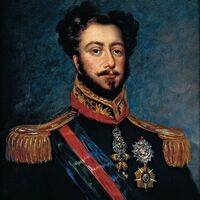
Emperor Dom Pedro I at age 35, 1834
With the independence in 1821 of Mexico and Peru the whole of the Spanish Empire in South America had declared for liberty. Portuguese Brazil followed suit in 1822, drifting into independence with astonishing ease. With Napoleon's invasion of the Iberian Peninsula in 1807, the royal family arrived in Brazil, and Rio de Janeiro found herself the centre of the Portuguese Empire. The prince regent Dom John VI immediately took measures to improve Brazil's economy and administration. Portugal's previous commercial monopoly was ended, bringing much new trade. Appropriate institutions were founded in keeping with a royal capital: royal treasury, national bank, printing office, library, military academy, and court of justice. In 1821, King John VI hurried home to secure his crown in Portugal, leaving his twenty-two-year-old son Dom Pedro as regent. When Lisbon then tried to take steps to reduce Brazil to her former colonial status, in September 1822 Dom Pedro simply proclaimed her independence with himself crowned emperor. During 1823 the practical necessity was undertaken of driving out of Brazil the various Portuguese garrisons, with Admiral Cochrane recently arrived from Peru to guard the coast against relief from Portugal. King John VI recognised Brazil's independence in 1825.
There were adjustments during the next two decades, with Uruguay going its own way from Argentina in 1828, and the Central American Federation divided by 1838 into five independent states. By this time only British Belize and the various settlements in Guiana remained under European control. Subsequent events suggest that Spain had left her colonies ill-equipped for self-rule. They were naturally inclined to oligarchies of the small privileged groups of Europeans, supported by the forced labour of illiterate peasants. However, centuries of autocratic rule by Spain had not prepared these oligarchs to transfer power among themselves peacefully. The result was a pattern of prevailing political chaos in which ambitious and ruthless leaders, usually emerging from the army, became dictators.
Political Reform in Britain[]
Though Napoleon had been defeated, the ideals of the French Revolution could not be and the years after the victory were uneasy ones in Britain. Economic hardship aggravated by an appalling harvest in 1816 brought a burst of Luddite raids on factories to smash the machinery that was threatening the jobs and livelihoods of skilled craftspeople. The ruling classes, neurotically fearful of radicals, responded with repression; a cavalry charge on a peaceful protest resulted in the Peterloo Massacre (1819) which left eleven dead and nearly five-hundred injured. Later in the year parliament passed the so-called Six Acts, designed to enforce public order by limiting the right of assembly and freedom of the press. However, it proves impossible to suppress the radical journalism of reform campaigners like William Cobbett whose weekly Political Register had an astonishing circulation of about fifty-thousand copies. George IV, prince regent from 1811 during his father’s frequent bouts of insanity and king in his own right from 1820-30, became a particular target of the people’s ire; notorious for his dissolute life of drink and gambling. Meanwhile, the Duke of Wellington, the prime minister in 1828, insisted that he saw no need for any political reform at all. However, events quickly overtook him.
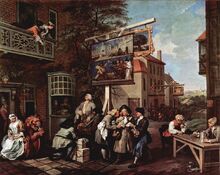
Canvassing for Votes by William Hogarth depicting the political corruption endemic in election campaigns prior to the Reform Act.
The need for parliamentary reform due to anomalies from the past was laughably evident in the so-called Rotten Boroughs. The borough of Old Sarum was particularly notorious for having seven voters for two members of parliament. There also still existed Pocket Boroughs with no voters at all, yet the owner's nominee automatically becomes a member of parliament; one such borough was entirely notional having vanished under the sea due to coastal erosion. Meanwhile votes were openly bought for stated prices, and landowners routinely victimised tenants for failing to vote for their nominees. If these traces of the past were a bad joke, the failure to address present realities was even more serious. The rapidly growing industrial cities were for the most part unrepresented. When Wellington's Tory dominated parliament rejected a bill to extend the franchise to Birmingham, Leeds and Manchester, the government was brought down, and a new Whig ministry committed itself to reform. The passage of the Reform Act was one of the most prolonged and dramatic in the history of the British parliament. The Tories worked tirelessly to prevent its passage through the House of Commons, so the Whigs called for fresh elections and were returned with a landslide majority. When the bill was finally passed by the Commons, it was then blocked by the House of Lords, prompting the Whig government to resign. With a wave of riots sweeping the country, the Whigs were eventually recalled and the Reform Act was finally carried, albeit in a somewhat watered-down form. Seats were granted to the industrial cities and most of the rotten boroughs were abolished, though the property qualification for voters still remained high. The immediate change may not have been great, but the shift in direction towards universal suffrage was immense. It was achieved in Britain in four successive stages: 1867 reduced the property qualification to the point where the urban working class won the vote; 1872 introduced the vote by secret ballot, which again provoked a great deal of parliamentary opposition; 1885 effectively gave the vote to workers in the countryside; and then in 1918 the financial threshold was done away with, as were as giving the votes to women. This ability of the British parliament to implement gradual reform, albeit with great reluctance, would allow Britain to avoid the kind of dramatic revolutions that would rock Europe in the decades to come.
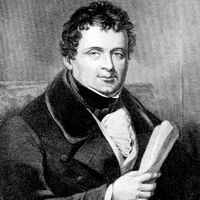
Portrait of Daniel O’Connell, "The Great Emancipator"
Meanwhile equally dramatic political reform had been taking place in the British kingdom of Ireland. The issue of Catholic Emancipation was brought back onto the agenda by a brilliant use of grassroots politics by Daniel O’Connell. From 1823, he organized a network of Catholic Associations throughout Ireland to demand an end to discrimination. There was actually considerable sympathy on the issue in England as an unmistakable expression of the popular will, but bills for Catholic relief were repeatedly rejected in the Lords. In 1828, O’Connell raised the stakes, winning the election for Clare by a landslide, even though his religion prevented him sitting in parliament. With Catholic Ireland in uproar, the prime minister, Wellington, was forced to pass the Emancipation Act, removing nearly all the Penal Laws including the barriers against Catholics holding public office. Then in 1840, O’Connell turned to agitation for repeal of the Act of Union. He pioneered a peaceful form of popular protest by organising mass demonstrations known as Monster Meetings. When the British parliament banned the meetings, O’Connell to the dismay of his more radical colleagues took the statesmanlike decision to call off the events. However, the government failed to respond in the same spirit; O'Connell and others were tried, convicted and imprisoned for seditious conspiracy. The movement for the repeal of the Act of Union may have continued, but in 1845 a harsher reality intervenes; the Irish Potato Famine.
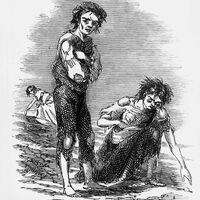
Scene at Skibbereen during the Great Famine, by James Mahony, commissioned by The Illustrated London News, 1847.
Since the 17th century, Irish peasants had come to rely on a single reliable and high-yielding crop, ideally suited to the subsistence smallholdings most Catholics had been reduced to. Between 1845-49, a previously unknown blight ravaged potato crops. The response of British government to the crisis, by then the possessors of the largest empire in the world, was inadequate. Much of the financial burden of providing for the starving masses was thrown upon the Irish landowners themselves and British absentee landowners. The result was the worst famine to occur in Europe in the 19th century. Many starving families grasped at the chance of a new life in America, becoming the first and largest group of Europe's dispossessed to cross the Atlantic in a great wave of emigration. It is calculated that one million people were direct victims of the famine, and another one million emigrated to America. Ireland’s population continued to decline in the following decades due to lower birth rates and continued overseas emigration. The famine was a watershed moment in the history of Ireland, souring already strained relations between many Irish and the British Crown. It became a rallying point for Irish nationalism, and when political agitation re-emerged, it would take-on a far more aggressive form.
British Empire[]
For the British Empire, the loss of the American Thirteen Colonies would bring a change in direction, with Asia and the Pacific becoming new targets for expansion.
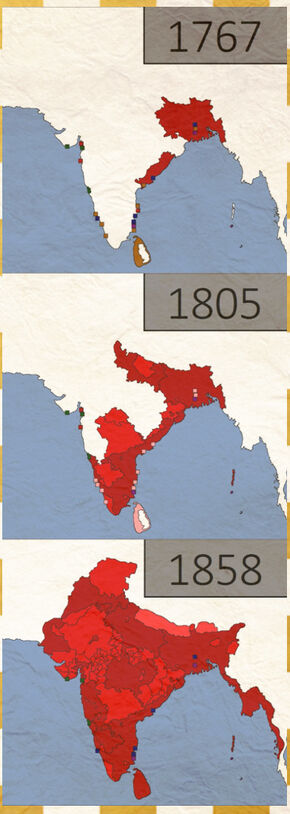
In India, after the almost unintentional acquisition of Bengal by Clive of India during the Seven Years’ War, the East India Company tried to ruled the region through an Indian puppet prince, but he soon tired of British interference and endless avarice. His rebellion ended in defeat at the Battle of Buxar (1764), firmly establishing the British as masters of Bengal. The Company's new domains inevitably made it a participant in the complex politics of post-Mughal India. As it formed alliances with neighbouring states to keep potential enemies at bay, the British were drawn deeper into the rivalries between India’s patchwork of states. Almost reluctantly, the British became embroiled in a three-way conflict with the two most powerful kingdoms to emerge from the disintegration of the Mughal Empire; the Anglo-Mysore Wars (1766–99) and Anglo-Maratha War (1772–1818). The Company quickly developed beyond a purely commercial enterprise into a military power on the sub-continent; by 1778 AD it had 67,000 troops. These troops were recruited largely from the Indian population through the enmity between social and religious groups, and trained along European lines, quickly becoming the most powerful military force in India. On emerging from the wars with Mysore and Maratha, the British, under the auspices of the East India Company, found themselves through a policy of divide-and-rule in control of virtually the whole of the vast sub-continent of India except for the north-west, either directly or through alliances with local princes. On the death of these native rulers, the annexation of their territory became almost routine. The absorption of Oudh in the north in 1856, long under Britain's indirect control, was the last major piece added to the Company's possessions. The north-west including the Punjab remained independent under the remarkable Sikh ruler, Ranjit Singh (1799-1839). However, after his death the Sikh empire rapidly fell into chaos, and the Company marched in and brought it under its control by 1849. Trade and profit continued to be the main focus of British presence in India. It provided a vast new territory for her manufactured good, while the economy in India was transformed to produce only raw materials for export particularly tea, coffer, cotton, iron, and coal; India's own cottage industries were ruined. Meanwhile, in conquering the sub-continent, British attitudes towards Indian culture had changed. Until 1800, the Company traders adapted themselves to the country, donning Indian dress, and learning Sanskrit. As British rule strengthened, it was increasingly felt that Indian learning and literature were of virtually no value. Christian missionaries were brought in, and laws were passed to abolish Indian customs such as suttee. English was enforced as the language of government, considered critical in a country with so many languages, but it also kept the new rulers at arm’s length from the Indian people. From 1784 onwards, the British government in London began to take a more direct role in supervising affairs in India, and formally after the Indian rebellion of 1857.
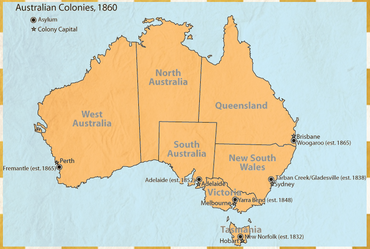
Meanwhile, from the the early 16th century when European merchants began sailing the seas of south-east Asia, rumours of an unknown southern land or Terra Australis had flourished. Australia was first encountered by the Dutch navigator Abel Tasman who made landfall on Tasmania in 1642. He also reached New Zealand, Tonga, and the Fiji islands on the same voyage, remarkably sailing all the way round Australia without noticing it. Mainland Australia was finally discovered by British explorer James Cook who charted the entire east coast. From 1788 Europeans began to settle. The lives of the original Australians were not about to improve. By the mid-18th century, Aborigines probably numbered about 300,000, spread thinly across the entire continent in an interconnecting pattern of tribal territories. None of the animals indigenous to Australia were suitable for herding, so the inhabitants lived by their traditional methods of hunting and gathering. The religious cult of the Australian tribes linked living people with an eternal spirit world referred to as the “dreaming”. The dead return to this other world, from which they would be reincarnated. Rituals were enacted in a lively tradition of dance, painting and music. The first British use of Australia was as a destination for convicted criminals. In 18th-century England, with a vast divide between rich and poor, the laws protecting property were draconian. Theft on even quite a trivial level was punishable by imprisonment or preferably transportation abroad; the American colonies had been the usual outlet before the revolution in 1776. The first 750 convicts arrived at the penal colony at Botany Bay in January 1788; later named Sydney in honour of the home secretary, Viscount Sydney. Despite a lack of agricultural skills, the colony somehow survived the first two desperate years, until the next batch of convicts arrived. This second fleet brought prison-guards with their families intent on making a prosperous new life for themselves, through the shamelessly exploitation of the convicts. Within three years the colony was well established, and free citizens began arriving of their own free will. Meanwhile, Hobart was settled in 1804, Brisbane in 1824, Perth in 1829, Melbourne in 1835, Adelaide in 1836 and Darwin in 1869. The clashes between British settlers and the native inhabitants were the most brutal and unequal of the colonial era. The Aborigines were particularly defenceless, and the settlers, a large proportion of them convicts or ex-convicts, were exceptionally violent; sometimes shooting natives in a mood of sport. The most shameful mistreatment was in Tasmania. Within twenty-five years of the British arrival, the native population had dwindled from two-thousand to two-hundred through conflict and especially disease. From 1831 these few were removed to the tiny Flinders Island in Bass Strait; before the end of the century the entire community had died out. From the middle of the 19th century the nature of Australia's colonies were transformed by gold. Starting in 1851, gold was found at several sites in New South Wales and Victoria. Thousands rushed to each new area as finds were reported; the population of Victoria went from 75,000 in 1851 to nearly 300,000 within just three years. This economic frenzy brought to Australia the first group of non-European immigrants. Within six years of the first find, there were some 24,000 Chinese in the Australian goldfields. Their presence prompted immense racial hostility, and this experience lies behind a much criticised policy which prevailed until the 1960s; that of White Australia.
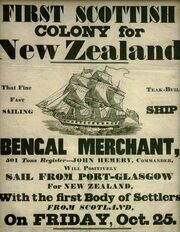
1839 poster advertising emigration from Scotland to New Zealand.
The British colonisation of New Zealand was somewhat more harmonious. The Māori were more advanced than the Aboriginals having settled the land, every corner of which came within the influence of a tribe. A few small European settlements were established from the 1790s onwards, mainly interested in seal skins, whale oil and timber. They were largely welcomed by the Maori, keen to trade in iron implements, alcohol, and especially firearms. Muskets would transform the incessant inter-tribal warfare, with the bloody Musket Wars (1807–42) raging until a new balance of power was achieved between the tribes. Significant European settlement only began after 1840 when the Treaty of Waitangi (1840) formally established New Zealand as a British colony. Soon the Māori came under increasing pressure to sell their land for settlement, leading to war in the 1860s. During or after twenty years of war, much Māori land was confiscated or bought.
The Century of Shame in China[]
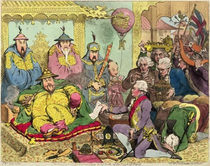
Lord Macartney saluting the Qianlong Emperor, 1793.
The Qing Dynasty (1644-1911) had reached its most splendid and prosperous era during the capable rule of the Qianlong Emperor (1735-96). China ruled one-third of the world's population, and had an open internal market that put it on a par with the British Empire economically. Yet the Europeans had been almost entirely excluded from this massive market since the restrictions imposed on trade begun by Emperor Kangxi in 1686. This left Canton the only port open to foreigners, through which the Chinese were happy to trade but only for hard currency. An enormous trade deficit developed with precious European silver, especially British, draining away to the Chinese to feed the passion for silks, china and especially tea in Europe. An intriguing glimpse of the European frustration can be seen in the experience of the British and Dutch trade missions which were received in 1793 and 1794 at the court of the Qianlong Emperor. The first envoy Lord Macartney from Britain travelled to Beijing carrying gifts that had proven popular in the past; scientific instruments, clocks and watches, a planetarium, and even a hot-air balloon. When presented to the emperor, Macartney refused the traditional kowtow, agreeing only to kneel on one knee and bow his head. The Qianlong Emperor refused to discuss practical matters of trade throughout their meeting, and three weeks later Macartney received a letter from the emperor for King George III saying “Our Celestial Empire possesses all things in prolific abundance and lacks no product within its borders. There is therefore no need to import the manufactures of outside barbarians in exchange for our own produce.” Macartney was widely blamed for his refusal to kowtow, but the following year a Dutch ambassador was calculated to have kowtowed no less than thirty times. He too returns home without a trading agreement. However, Britain was determined to open-up China to free-trade by any means necessary, in one of the first and most dramatic demonstrations of Gunboat Diplomacy. On the heels of the Industrial Revolution, the Europeans had managed to convince themselves that other societies were backwards, thus giving them the right to force their values on others. Meanwhile, closing herself off to the outside world and the relative peace during the Qing Dynasty had left China’s military lagging far behind that of the Europeans.
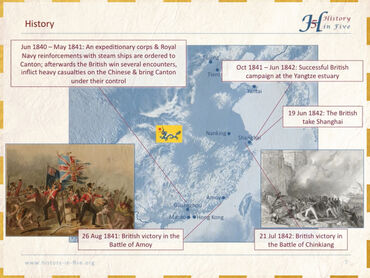
By 1800, the British had turned to Indian opium to balance the trade with China, smuggled across the border from Calcutta. Opium had long been used in China to treat some ailments, but recreational use not widespread. That changed when the British and others began shipping in tons of the drug, resulting in widespread addiction in China and a serious social crisis. By 1839, 1,400 tons of opium would be pouring into China every year. The Chinese government responded in March 1839 by confiscating and destroying more than twenty-thousand chests of opium from British warehouses at Canton; there was a promise to eventually compensate the traders for their loss. From now on, all foreign merchants to China were ordered to sign a "no opium trade" bond. The British rejected the legitimacy of China’s opium ban, despite the fact that the trade was also illegal in Britain, and began a naval blockade of Canton. The First Opium War (1839-42) began when a British merchant vessel tried to run the Royal Navy blockade. When the Chinese navy tried to escort the vessel into Canton, the Royal Navy opened fire on the out-classed Chinese war junks, sinking four and forcing the rest to withdraw. Seven months later, a full-scale expeditionary force of 44 British ships arrived in Chinese waters. The British captured Zhoushan (July 1840) and Chuenpi (January 1841) islands threatening Shanghai and Canton, but still the Emperor refused to negotiate. So they determined to bring this once great empire to its knees and force them to trade on their terms. The British fleet proceeded up the Pearl River estuary to Canton and attacked and occupied the city in May 1841. They then march north-east from Canton delivering defeat after defeat on the Qing forces, and eventually capturing Shanghai and Zhenjiang by July. With the British now threatening Nanking, the key to the Yangtze River, the Chinese Emperor finally opened negotiations and conceded on nearly every point: Britain was granted twenty-one million silver taels in war reparations, the island of Hong Kong was ceded to the British crown in perpetuity, and four additional ports were opened to foreign trade alongside Canton.
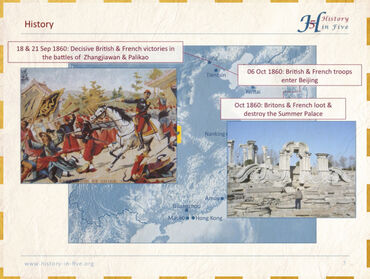
Yet the Treaty of Nanking failed to legalise the opium trade or to satisfy the British goal of improving the trade deficit. These problems would be resolved some twenty years later in the Second Opium War (1856-60). The pretext for the war came in 1856 when the Chinese seized a Chinese-British cargo ship accused of piracy, incorrectly as it turned out; the ship had previously been used by pirates but subsequently resold. The Chinese released the prisoners but refused to apologies, so Britain declared war again, this time joined by France; the French were upset at the death of an illegal Christian missionary killed in a Chinese province that was illegal for foreigners to enter. The Chinese were in the midst of the Taiping Rebellion (1851–1864), and immediately sued for peace offering generous concessions, but the British and French wanted more. Their forces landed near Tientsin at the head of the Yellow River, and marched on Beijing. In October 1860, the British and French took the Chinese capital, and looted and destroyed the Summer Palace, a masterpiece of Chinese landscape garden design. The Chinese had little option but to accept the Treaty of Tientsin: opening eleven more ports to foreign trade, establishing foreign embassies in Beijing, allowing Christian missionary activity, ceding the whole Kowloon peninsula near Hong Kong to the British, and of course legalised the opium trade. The humiliation of the Opium Wars has been seared into the Chinese consciousness to this day, and began what the Communists called “the century of shame”.
In was clear that Western Europe was now the military and economic powerhouse of the world, thoroughly eclipsing China. The traditional explanation for this is the rather prejudiced assertion that European culture was more dynamic. Numerous factors contributed to the Chinese decline. Firstly, China had her own brief Chinese Age of Discovery some fifty years before the Europeans, exploring as far as West Africa but found little that they needed, unlike Europe which explored and ultimately colonised the world driven initially by a desperate desire for spices. Secondly, the Chinese failed to industrialise even through it clearly remained innovative as evident in numerous strides in agricultural best practice. One challenge was geography; 98% of China’s coal supplies were located to the north of the Yangzi, and region both distant and unstable. For China to have achieved the results that the West did would have been even more exceptional than what came to pass in Europe. Finally there are the cultural-political factors. The lack of any significant military threat for centuries in East Asia, and the policy of isolation meant China did not learn from the Western military advancement.
Russian Autocracy[]
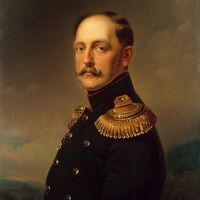
Portrait of Tsar Nicholas I of Russia
Russia's first revolution follows immediately on the death of Alexander I in 1825, the grandson of Catherine the Great. Since the second half of the 18th century there had been a movement within Russia for constitutional reform, representative government, and an end to serfdom. During the Napoleonic Wars it became associated with secret societies within the army. Alexander I had no children, and in the confusion between which of two brothers should inherit the throne, the radicals seized their opportunity; the Decembrist Revolution (1825). When the imperial family settled on the younger brother Nicholas I (1825-55), in a calculated coup the army took to the streets demanding the older brother Constantine and a constitution. The confrontation ended when Nicholas gave the order to fire grapeshot from his artillery at rebels in a square in St Petersburg. The leaders of the plot were then arrested, with five eventually hanged. The Decembrists were later revered as the first martyrs in Russia's long revolutionary tradition. The uprising was a prelude to the long and increasingly oppressive reign of Nicholas I. Censorship of the press was omnipresent, and a secret police ran a huge network of spies and informers, forcing radicals underground during his reign. He established an ideology called "Official Nationality" where people must show loyalty to the Tsar, the Orthodox Church, and in a vague way to the Russian nation. These principles gained little support among the Russian people, and instead were used as a means of repression especially of minority groups and religions. Historians are near unanimous in their damning verdicts of Nicholas’ reign. He’s been called the emperor who froze Russia for thirty years. This failure to implement even minor reforms would ultimately lead to the rise of the Bolsheviks. Furthermore, his obsessive micromanagement of the army would hinder his generals when Russia found herself at war in the Crimea.
United States[]
After achieving her independence, the area south of the Great Lakes was the first trouble spot to demand the attention of the new United States of America, where it’s expected numerous new territories would emerge and enter the Union once they had a population of sixty-thousand free inhabitants. Scant attention was given to the interests of the Indians living there, with violent Kentucky frontiersmen creating mayhem in raids on their villages, and equally violent reprisals from the Miami and Shawnee tribes. The first two military expeditions against the tribes ended in complete disaster, but the Americans had their revenge in the third under Anthony Wayne when they defeating the Indians at the Battle of Fallen Timbers (1794). This defeat gave the green light to a surge of new land speculation and settlement. Until 1813, Indian resistance to this encroachment was gallantly continued, but the beginning of the National Road in 1811 was a powerful sign of American determination to open up the region.
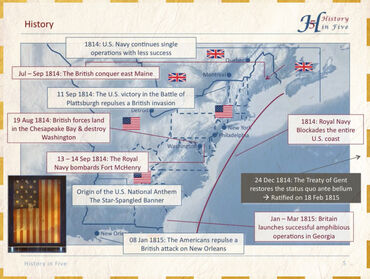
By 1793, France and Britain were at war, which would continue almost without interruption for the next twenty years. As the two Atlantic powers of the day, their conflict inevitably stifled maritime trade, especially as British control of the seas steadily tightened. With no consideration shown to neutral vessels, American shipping in the Atlantic was increasingly harried. When Britain imposed crippling restrictions on goods carried by neutral vessels in response to Napoleon's similar Continental System, the United States in a mood of exasperation declared war on Britain; the War of 1812 (1812-15). The British government were dismayed by the American declaration, seeing it with some justification as an opportunistic ploy to annex Canada while Britain was embroiled in a war with France. The war itself was brief and frustrating. The Americans tried to invade Canada and were repulsed in part thanks to an alliance with the Indians. At sea, the powerful Royal Navy blockaded the American coast, allowing them to raid at will, even burning Washington in August 1814. The Americans subsequently repulsed British attempts to invade the north and mid-Atlantic states, in the process breaking the myth of British naval invincibility. The war also reveals the hazard of conflicts in an age of slow communication; the most costly battle of the entire conflict fought near New Orleans in January 1815, took place two weeks after the peace treaty ending the war had been signed. No territory changed hands in the settlement, but for the first time the frontier between the USA and Canada was formally settled as running west from Lake of the Woods along the 49th parallel. The war's resolution did ultimately lead to two centuries of peaceful and mutually beneficial intercourse between the U.S., Britain and Canada so in a way everyone won, except of course the Indians who suffered significant casualties and gave up even more territory.
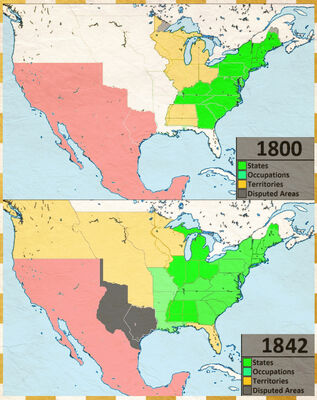
The fact that before the war, many Americans wanted to annex British Canada was swiftly forgotten, and instead the American popular presentation of the war was as a successful re-assertion of American independence. It left the United States with a renewed sense of confidence, especially after its territory had doubled in size after the Louisiana Purchase (1803) from Napoleon for $15 million; Napoleon had forced an abject Spain to return Louisiana to France in 1801. The purchase of Louisiana had the added advantage of securing the port of New Orleans for the trading activities of the American settlers flourishing east of the Mississippi. America had tried to seize Spanish Florida during the War of 1812, using the pretext that Spain was then allied with Britain in the war against Napoleon, however they were twice repulsed. In the end, Spain sold Florida to the USA in 1819 for $5 million. By 1823, the United States had the confidence to put down an international marker, the Monroe Doctrine. It stated that the U.S. would not interfere in any European wars or existing colonies, but that the use of force to retake control of any independent state in North or South America would be viewed as "the manifestation of an unfriendly disposition toward the United States." There was an element of huffing and bluster about this, but nevertheless it was a ringing announcement that the U.S was now the dominant power in the region. With this established, the Americans devote their energies to increasing their advantage through westward expansion bringing the vast empty spaces under their control; empty, that is, except for the Indians. Early experiments with coexistence essentially ended with Andrew Jackson, the first president from west of the Appalachians who knew at first hand the aggressive land hunger of the frontier settlers. In 1830, he passed the Indian Removal Act to persuade tribes to exchange their land for territory beyond the Mississippi. Persuasion soon blended into enforced relocation. It’s been calculated that about 100,000 of the Five Civilized Tribes were driven from their land, and that more than 20,000 die on the Trail of Tears. The territory promised to the tribes “as long as the grass grows and the rivers run”, lasted a few decades. The steady expansion of territory westward, dignified by the slogan “Manifest Destiny”, could be seen like squares being occupied in a board game: Ohio in 1803, Louisiana 1812, Indiana 1816, Mississippi 1817, Illinois 1818, Alabama 1819, Missouri 1821, Arkansas 1836, Michigan 1837, Texas 1845, Iowa 1846, and Wisconsin 1848. By 1848, the Americans were intruding into what was clearly Mexican territory in Texas.
Late Industrial Revolution[]
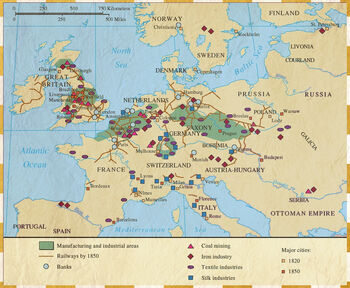
After the early British Industrial Revolution, industrialisation inevitably spread, though the British tried unsuccessfully to prohibit the export of their technology and skilled workers. By 1809, Westphalia in Germany was called “Miniature England” because of its similarities to its industrial areas. Thanks to coal, Belgium quickly geared up to become the second industrial power in the world by the middle of the 1820s. In France and the United States the process of economic growth and industrialisation was slow and steady. Thus by the mid-19th century, industrialization was well-established throughout the Western Europe and America’s north-eastern region. The increasing availability of petroleum and electricity in the late 19th century would further widened the potential for industrialisation to coal-deprived areas like northern Italy. The Industrial Revolution brought about a greater volume and variety of factory-produced goods and raised the standard of living for many people, particularly for the middle and upper classes.

Trevithick's 1802 locomotive. This full-scale reconstruction is in the National Waterfront Museum, Swansea.
With industrialisation, the transportation industry also underwent significant transformation. Before the advent of the steam engine, raw materials and finished goods were hauled by horse-drawn wagons, and along canals and rivers. In the early 1800s, American Robert Fulton (d. 1815) built the first commercially successful steamboat, and by the mid-19th century, steamships were carrying freight across the Atlantic. As steam-powered ships were making their debut, the steam locomotive was also coming into use. In the early 1800s, British engineer Richard Trevithick (d. 1833) constructed the first railway steam locomotive. In 1830, England’s Liverpool and Manchester Railway became the first to offer regular, timetabled passenger services. By 1850, Britain had more than 6,000 miles of railroad track. Additionally, around 1820 Scottish engineer John McAdam (d. 1836) developed a new process for road construction, which became known as macadam and resulted in roads that were smoother and more durable.
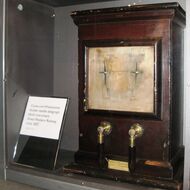
Cooke and Wheatstone's two-needle telegraph as used on the Great Western Railway
Communication too was becoming easier. In 1837, British William Cooke (d. 1879) and Charles Wheatstone (d. 1875), patented the first electrical telegraph, and in 1866, a telegraph cable was successfully laid across the Atlantic. Electricity was slowly making strides: in 1752, Benjamin Franklin flew a kite into a thunder cloud to demonstrate the nature of electricity; in 1800, Italian Alessandro Volta developed the voltaic pile to produce electric current; and in 1831, Englishman Michael Faraday devised a machine that generated electricity from rotary motion. However, it wouldn’t be until the late 19th century that the technology reached a commercially viable stage. Meanwhile, the Industrial Revolution also saw the rise of banking and industrial financiers. A stock exchange was established in London in the 1770s; the New York Stock Exchange was founded in the early 1790s. In 1776, Scottish social philosopher Adam Smith (1723-1790), who is regarded as the founder of modern economics, published “The Wealth of Nations”. In it, he promoted an economic system based on free enterprise, the private ownership, and lack of government interference.
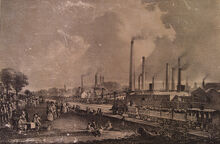
Levels of air pollution rose during the Industrial Revolution, sparking the first modern environmental laws to be passed in the mid-19th century.
The availability of work in industry had the effect of drawing ever-increasing numbers of people from the countryside into rapidly expanding cities. For instance, Manchester had 25,000 inhabitants in 1772, and by 1851 this conurbation had grown to 455,000. To a detached observer the Industrial Revolution can seem romantic in the 1780s, but it soon became evident that it created an environment in which it could be extremely unpleasant to work. Factories owners welcomed a supply of labour trapped by economic circumstances into accepting dangerous and monotonous working conditions, with little job security, long hours and low pay. Children were part of the labour force, often used for such hazardous tasks as cleaning the machinery; in the early 1860s, about 20% of the workers in Britain’s textile industry were under fifteen. Regulations, which todays seem astonishing, were only gradually introduced and then poorly enforced. Britain’s Factory Act (1802) required a child to work no more than twelve hours a day. By 1833, children under nine were not to work at all, and those under thirteen were limited to eight hours of work. At the same time, there were only four inspectors to enforce these regulations for the entire country. Meanwhile, living conditions were invariably poor, with industrialized areas unable to keep pace the flow of workers arriving from the countryside. The result was polluted, unsanitary, and overcrowded housing in which disease ran rampant. Conditions for the working-class began to gradually improve by the later part of the 19th century, as governments instituted various labour reforms and workers gained the right to form trade unions.

